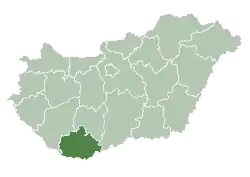Kisbudmér
Kisbudmér (German: Kleinbudmer; Croatian: Mali Budmir) is a village and municipality (Hungarian: község) in Baranya county, Hungary.
Kisbudmér
Kleinbudmer | |
|---|---|
Municipality | |
 | |
 Kisbudmér Location within Hungary. | |
| Coordinates: 45°54′53″N 18°26′46″E | |
| Country | |
| Region | Southern Transdanubia |
| County | Baranya |
| District | Bóly |
| Government | |
| • Type | Mayor-council government |
| • Mayor | Ferenc Kelemen (Ind.) |
| Area | |
| • Total | 5.72 km2 (2.21 sq mi) |
| Population (2022)[2] | |
| • Total | 87 |
| • Density | 15/km2 (39/sq mi) |
| Time zone | UTC+1 (CET) |
| • Summer (DST) | UTC+2 (CEST) |
| Postal code | 7756 |
| Area code | 69 |
| Geocode | 22868 |
Etymology
The name comes from Slavic personal name Budimír.[3] Budmer (1291).[3]
Until the end of World War II, the majority of the Inhabitants were Danube Swabians, also called locally as Stifolder, because their ancestors arrived in the 17th and 18th centuris from Fulda (district).[4] Mostly of the former German Settlers was expelled to Allied-occupied Germany and Allied-occupied Austria in 1945–1948, about the Potsdam Agreement.[5] Only a few Germans of Hungary live there, the majority today are the descendants of Hungarians from the Czechoslovak–Hungarian population exchange. They got the houses of the former Danube Swabians Inhabitants.
Geography
Kisbudmér is located in Baranya County, about 25 kilometers southeast of Pécs, 9 kilometers southwest of Bóly and 13 kilometers north of Villány. It is about 25 kilometers west of the Danube, 20 kilometers from Croatia and 40 kilometers from Serbia. The municipality lies within the Southern Transdanubia Region of Hungary. It previously was part of the Mohács Subregion but during the creation of districts in 2013, it became part of Bóly District.
Demographics
During the census of 2011, the population was 113. The vast majority of the population claimed Hungarian ethnicity (92.2%). Other ethnicities claimed included Roma (4.3%), German (3.4%), Romanian (1.7%) and Other (1.7%). 6% did not wish to answer. In terms of religious practice, 44% reported to be Roman Catholic, 4.3% Calvinist, 21.6% of no religious affiliation and 29.3% did not wish to answer.[2]
Transport
The closest railway station is in Villány, 13.6 kilometers to the south.
References
- "Municipal Elections 2014" (in Hungarian). Hungarian National Election Office. Retrieved 5 June 2019.
- "Detailed Gazetteer of Hungary". Hungarian Central Statistics Office. Retrieved 19 November 2022.
- Kiss, Lajos (1978). Földrajzi nevek etimológiai szótára (in Hungarian). Budapest: Akadémiai. p. 338.
- https://www.feked.hu/etc/Stifolder_tortenet.pdf.
- "Die Vertreibung – Landsmannschaft der Deutschen aus Ungarn".

